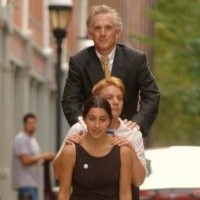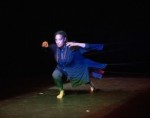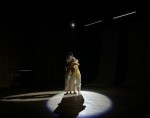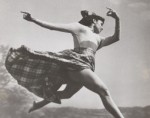
Photo: Andrew Simonet
Revealing Neighborhood Mysteries and Artistries
by Jonathan Stein
At their best, Headlong Dance Theater turns the tables on our expectations of performance while being committed to the physical body as the oft forgotten story-teller and memory bank of our lives’ experiences. In the spirit of a utopian performance adventure, Headlong shines in the current Live Arts Festival offering
This Town is a Mystery, which brings audiences of 12 into the working class homes of four families in local Philadelphia neighborhoods.
The families perform as “citizen dancers,” in the words of Headlong co-director Andrew Simonet, a more apt description than the more often used, somewhat perjorative, “non-dancers,” “non-professionals,” or just plain “amateurs” (as the New York Times recently described dancers in Le Grand Continental, the dance for 150 reprised here in the Live Arts Festival this month, with this writer included). Philadelphia households from Tacony, South Philadelphia, Wissinoming and South Philadelphia tell their life-stories in a ground floor room of their own homes with the aid of lighting, space, sound and costume designers, through dance-theater and spoken word. Each audience member is instructed to bring a pot luck dish to a post-performance dinner in the same space, a communal meal that seals a profoundly moving experience for both performers and audience.
Lea Bostick, 53, first saw word of this heady experiment in an ad last winter in the Metro, not the usual journal for performance auditions or solicitations, and she was one of the lucky four households among 40 applicants chosen. As someone who had engaged for over three decades in her Buddhist church theater productions, she described to me her motivation in having a chance to “dance, perform and have fun.” Her desire to get chosen was sufficiently strong that she submitted pictures of her potential co-performers, her son Adam, 28, and daughter, Princess, 24, because she knew how photogenic they are (fully confirmed by this viewer). She described being vetted by Simonet, who asked them if any were shy, and Lea told him, “Shy was the only gene they didn’t have.” The nine months of intense rehearsal practice and exploration of their own lives via Simonet’s interrogating and directing proved far more transforming, they said, than they could ever imagine.
To a James Brown number the family members enter individually from a rear living room, its subdued quality of light suggesting family memories, into a cleared dining/kitchen space, with one wall enlivened by family photographs. We are introduced to each via their voiceovers accompanied by the occasional recorded barks of a family dog. We see a slow trio to the music of a love ballad where their solitary, unconnected gestures, frozen poses and hands over faces reveal individual sadnesses sharing the same abode. They separate, and a series of solos begin. First Adam relates how at age 18, while working at a job cleaning empty houses, he found a plastic bag with $12,000. The discovery led to an eight month coming-of-age experience in California. We visualize his story out of props he pulls from his kitchen: sugar emptied onto half of a plate for those sandy beaches, blue colored Gatorade poured adjacent, and a single wafer dropped into this turquoise blue as his bobbing surfboard.
A pause. Princess opens the nearby refrigerator to retrieve a bottle of pink medicine that she then delivers upstairs to her ten month old infant, Preston. We soon learn that he has spent most of his short life struggling to stay alive in a Neonatal Intensive Care Unit. The performance resumes (or continues) with a dance solo by Lea, rippling her shoulders and upper arms and swaying her hips to a Caribbean beat.
The mother then delivers a series of short monologue stories, anchoring us with her direct eye contact and charming delivery. Her tales are often introduced with a photograph she takes from the wall to pass through the audience. One of the various voices she embodies is her own feisty mother, the family’s matriarch. Although she remains seated, she animates her stories with an expressive face and active arms and hands that punctuate her memories of her mother bringing her into the city for Saturday shopping and meals; gambling at a casino; and her own embrace of Buddhism (including a long-time practice of Japanese chanting two hours daily). She and son Adam then dance a conflicted duet of both aggressive martial arts gestures and extended arms of acceptance. The audience seems especially struck with a number of risky but perfectly executed, total body, back-drops by the mother into the lowered arms of the son—a powerful expression of trust and love.
The arc of the half-hour performance leads to a mesmerizing monologue by Princess. In a now darkened room and on her knees, within a few feet of us, she tells the story of her son Preston, born prematurely, weighing little more than two pounds, and her “living for seven months” in the hospital NICU facility with her Buddhist faith as her strength. Before her, in lieu of her infant son, her brother lies supine, with one arm raised and cupped in her hand, “exactly” (she says later during dinner) as she had held her infant’s arm through the months in the hospital.
Conversations with the performers during our post-performance meal revealed how transformative was the learning and performance experience for the Bostick family, and, I can say, equally for myself as an audience member. This mutuality of a shared artistic adventure is a rarity in the performance world. Headlong’s successful experiment revealed not only the omnipresence of life’s mysteries amongst all of us, but also our potential to access them through artistic expression.
This Town is a Mystery directed by Headlong Dance Theater, performed in four Philadelphia households Sept. 7-22, performances sold out. The author saw Adam Bostick, Lea Bostick and Princess Bostick at their home in the Tacony neighborhood of Northeast Philadelphia.
See also Kilian Kröll on
another household in This Town.
By Jonathan Stein
September 18, 2012











